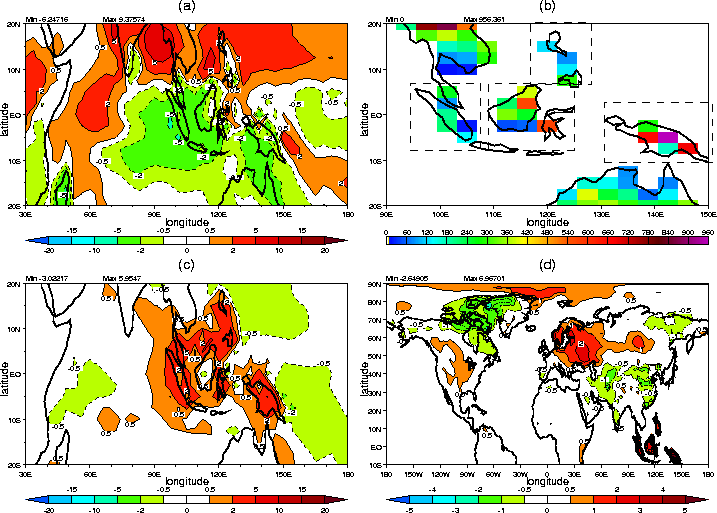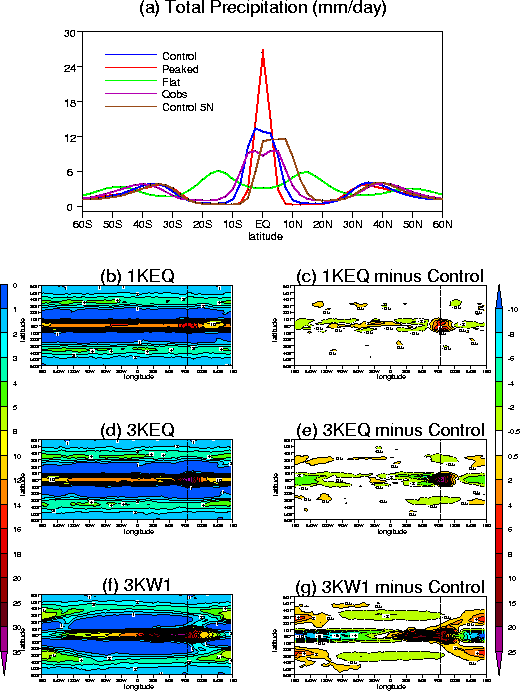
Coordinator: Julia Slingo
1. It has been demonstrated that an improvement in the spatial distribution of tropical heating associated with the Maritime Continent can lead to significant improvements in many aspects of the global circulation and its interannual variability.
After much model development, persistent systematic errors in the UM remain. One particular region of interest is the maritime continent which has a deficit in precipitation (Fig. 1(a)). The maritime continent region is difficult to represent in course resolution climate models due to the complex distribution of the many elevated small islands in this convectively active area (Fig. 1(b)). To demonstrate the sensitivity of global systematic model errors to the heating in this region, two AMIP II experiments have been performed, one with the existing distribution of islands and a second where the island grid-points are replaced by sea grid-points with SST interpolated from existing adjacent grid-point values.
In the absence of the maritime continent islands, the local precipitation increases, reducing the existing dry bias and bringing the model closer to observations (Fig. 1(c)). In response to this improved heating distribution, precipitation also increases over the West Indian Ocean and SPCZ regions, again reducing the systematic dry bias. This supports the hypothesis that tropical systematic errors are often related through vertical (Walker) circulations.
Following on from improvements in the basic state, significant changes are also seen in the tropical interannual variability. For the Indian summer monsoon, for example, the interannual variability associated with El Nino has a stronger signal of the correct sign in the Indian Ocean basin which is was previously too weak in the standard AMIP II experiment.

The extra-tropical influence of changes to the tropical heat source is also well demonstrated. In northern hemisphere winter significant surface temperature anomalies are seen across much of North America and the North East Eurasian region (Fig. 1(d)). Indeed the response looks very much like the Rossby wavetrain pattern associated with La Nina conditions. In the southern hemisphere winter, significant surface temperature anomalies are associated with an equivalent barotropic Rossby wave response originating from the enhanced convective outflow of the maritime continent region.
2. The duality of monsoon condensational heating and subtropical anticyclones has been demonstrated; the monsoon heating reinforces the anticyclone which in turn, through the generation of enhanced lower tropospheric jets, supplies the moisture fluxes required to sustain the monsoon heating.
Using time integrations of a dry atmospheric model with prescribed heating, a new picture has been created of the low level global circulation as forced by mountains and monsoon convection. The poleward flow carrying moisture into a monsoon forms the western flank of a subtropical anticyclone. The eastern flank is forced both by the monsoon to the east and, for the Americas, by the mountain chain that occupies the west of the continent. Further, the observed `explosive' onset of monsoon rains suggests the existence of positive feedbacks between monsoon heating and the low-level subtropical anticyclone to the east. The strong reduction in SSTs in the Arabian Sea that accompanies the Asian monsoon suggests that surface latent heat fluxes act both as a moisture source and as a natural brake to the positive feedback.
3. The utility of idealised aquaplanet experiments for testing the interaction between the physical parametrizations and the dynamics in AGCMs has been demonstrated. A set of tests has been proposed for use by the international community under the auspices of the WCRP Working Group on Numerical Experimentation (WGNE).
In recent years, the comparison of the output from different AGCMs run under controlled conditions has been identified as vital in order to probe the reasons for differences in the systematic errors of the each of the models. However, this has proved difficult due to the complex nature of the many interactions that exist and because of the complexity of the spatial and temporal variability of the boundary conditions (e.g. land/sea distributions, SST forcing). While simple tests of the dynamical core of AGCMs has already been proposed, there is currently no test of the physical parametrizations, specifically their interaction with the dynamics. A set of eight numerical experiments is proposed as a test bed for the interaction of dynamics and physical parametrizations in atmospheric GCMs. The framework for the experiments is that of an aqua-planet in which the prescribed SSTs are highly idealized. It is not known what the "correct" solutions are. However, the solutions obtained with particular choices of schemes may indicate classes of behaviour and obvious problems.

Theoretical ideas can guide in the analysis and may in turn be developed by the consideration of the results. Example results are shown from version HadAM2b of the Unified Model (UM). The zonal mean circulation exhibits strong sensitivity to the latitudinal distribution of SST in which the presence of a single equatorial maximum, twin ITCZs or no tropical convective maximum depends on the near equator curvature of SST (Figure 2). There is also marked sensitivity to displacement of the SST maximum from the equator. Longitudinal variations of SST, in the form of warm pools or zonal wavenumber one perturbations, yield information on the linearity of the response, the longitudinal displacement of convective maxima from SST maxima, and the remote suppression of convection. The enhanced equatorward momentum fluxes associated with the generated Rossby waves also introduce a strong tendency to produce zonally averaged westerlies (i.e. super-rotation) on the equator.
Contributors: Brian Hoskins, Richard Neale, Julia Slingo, Mark Rodwell (Hadley Centre)